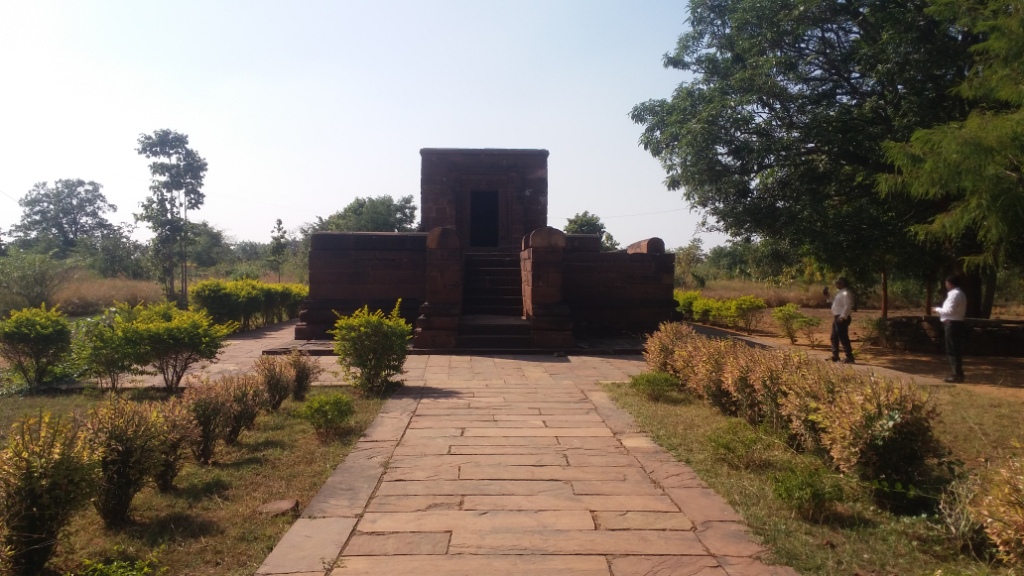Sri Bharkuleswar temple, Madhyapradesh

Address
Sri Bharkuleswar temple Bharkuleswar Temple Rd Near Maharaj pur, Satna District, Khamha, Madhya Pradesh 485001
Diety
Bharkuleswar (shiva) Amman: Durga
Introduction
The village and temple site of Bhumara rest on a largely shrubby hill plateau about 12 miles (19 km) northwest-west of the town of Unchehra, near the hills of Khamha and Mohnna. It is about 40 kilometres from Satna. Bhumara Temple, sometimes called Bhumra, Bhubhara or Bharkuleswar, is a 5th or 6th-century Gupta era Hindu stone temple site dedicated to Shiva near Satna, in the Indian state Madhya Pradesh. The temple has a square plan with a sanctum and Mandapa. While much of it is in ruins, enough of the temple structure and artwork has survived for scholarly studies. The temple is notable as one of the early examples of an architecture that included an enclosed concentric pradakshina-patha (circumambulation path). Like other early Gupta era Hindu temples, it includes a decorated entrance to the sanctum flanked by Ganga and Yamuna goddesses, and intricately carved sculptures.
Puranic Significance
The temple’s Ekamukha Linga, a mukhalinga or faced lingam, with a detailed head of Shiva, is a much studied example of Gupta art. The temple reliefs include those for Mahishasura-mardini (Durga), Ganesha, Brahma, Vishnu, Yama, Kubera, Kartikeya, Surya, Kama and others. A 5th-century relief sculpture at the Bhumara temple is significant in being one of the earliest known representations in sculpture of Ganesha. Many of the ruined parts of the Bhumara temple have been moved to museums, especially the Kolkata Museum and the Allahabad Museum. The Bhumara excavations have yielded numerous sculpture, broken pieces of walls and statues, as well as ruined parts of the mandapas. The recovered pieces included parts of another intricately carved doorway, larger than the one on the sanctum. It had river goddesses Yamuna (reasonably preserved) and Ganga (broken), but to their immediate vicinity the stone was smooth, unlike the sanctum doorway. The recovered portions of this broken doorway show that it also had three bands of carvings above the head of the goddess. This doorway likely was a part of the mandapa Portions of broken lintels found lying around the site show figures of erotes, in the same style as one finds in the ancient Khoh temples. The recovered fragments in the ruins when put together show that they are incomplete and parts have been lost. Other ruins found at the site included pilaster and pillar parts. These were square, hexagonal, octagonal or dodecagonal in cross section. The largest of these had square bases. Some were smooth, some carved. Pieces recovered show that the top and bottom portions had carvings. Many show foliage and designs that are now called the arabesque style. Lotus motifs are common. Some pillar shafts include huge kirtimukhas on each face. Some kirtimukhas are depicted with garlands hanging out of their mouths. Extensive slab ruins were also found near the mandapa platform. These are carved with various motifs and figures. They show people in their daily lives, warriors, ganas (dwarfs) holding various items such as sword in one hand and lotus in the other, some people with clean shaven heads and others with elaborate hairdos. Musicians, dancers, seated groups of men or women, animals, flowers and other scenes are set in medallions. Recovered wall panels of the Bhumara Shiva temple show Vishnu’s Narasimha avatar blowing a conch shell, Krishna and others.
Special Features
The three outer walls of the sanctum lack any decoration. They are smooth red sandstone. The side with an entrance into the sanctum is intricately carved and decorated. The sanctum door consists of a carved lintel, two carved jambs and a sill. To the right is goddess Ganga standing on her vahana Among the most important artefacts of Bhumara is a Shiva-lingam with a bust relief. which occupies almost the entire height of the lingam. Lingas with faces are called a mukhalinga, those with one face are called ekamukha linga. The Indian archaeologists visiting Bhumara temple around 1920 discovered a somewhat damaged ekamukha linga embedded within a stone pavement in the sanctum. It is 6.08 feet The Bhumara Shiva linga wears a jeweled crown, necklace and pearl ornaments
Century/Period/Age
5th or 6th century
Managed By
–
Nearest Bus Station
Unchehra
Nearest Railway Station
Unchehra
Nearest Airport
Jabalpur




